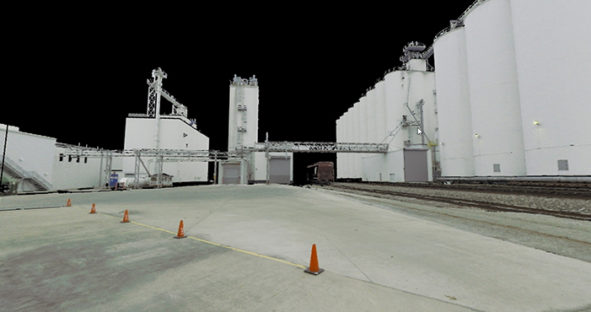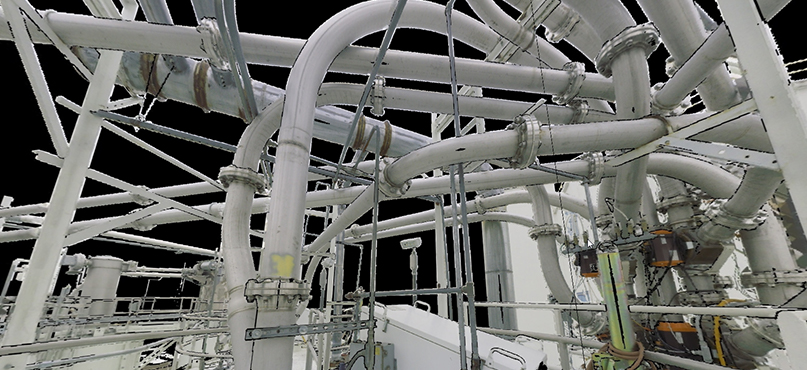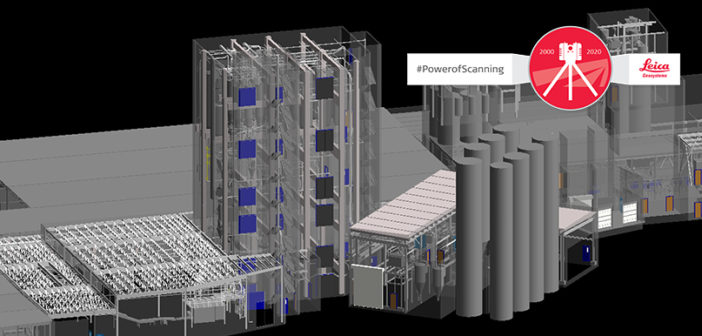Food processing plants can be so complex you need a map to get around. Especially when they have grown and evolved over a long period, as at 90-year-old “JIFFY” Mixes.
“JIFFY” Mixes produces baking mixes for both the home baker and the catering industry at its site in Chelsea, Michigan. A tour of the plant (open to the public) takes one and a half hours to complete. As part of a renovation programme, the company needed new data to replace out-of-date paper plans. Director of Manufacturing Scott Denny explains, “We knew that as we continued to upgrade the facility, we would need accurate, complete documentation to do so effectively.”

A technological pioneer throughout its history, “JIFFY” Mixes chose 3D laser scanning to capture the intricacies of its operation. 3D laser scanning is a process where a device (a laser scanner such as the Leica RTC360 for example) measures and records multiple points from whatever it scans. The captured data points form a point cloud, which can be used on its own or brought into CAD or 3D software and developed into a detailed three-dimensional model. The point cloud data from a laser scanner is so complete that it provides details as specific as the bolt pattern on steel pipe fittings, providing the insight needed to manage a plant remotely and keep it in peak performance.
Using “JIFFY” Mixes as an example, here we look at five ways 3D laser scanning benefits operations at a food processing plant or factory.
-
Scanning can be completed with minimal disruption to operations
Before, building or checking plant documentation was labour intensive. A team of people would need to take measurements, which can be disruptive in areas with machinery – especially where food is involved and contamination is an issue. More convenient, laser scanning captures measurements from a distance; it’s non-invasive. A scanner and a single operator can gather comprehensive information of an entire site.
“One of the benefits that really stood out to us was the ability to capture accurate documentation on the entire plant without affecting production,” explains JIFFY” Mixes Project Engineer Rick Rabideaux.
-
Up-to-date information means accurate design
“JIFFY” Mixes worked with Wightman, an expert in as-built data capture using 3D laser scanning, to build a digital twin of the plant. This gives the company accurate ‘as-is’ data that means all future design drawings use real-world conditions. This accuracy reduces the risk that any building works will be delayed because of mistakes in design.
“Instead of models and drawings that are outdated as soon as they’re complete, you have a living, breathing digital twin of your facility that you can continue to use over time for future renovation projects,” explains Michael Pfaff from Wightman.
-
Faster mapping accelerates project delivery
Laser scanning is a quick process, and the faster speed streamlines data capture onsite. This means less time spent mapping the factory and more time using the information gathered.
Pfaff and his team use a high-speed Leica RTC360 that captures comprehensive data in seconds. Combining the hardware with powerful point cloud processing and management software such as Leica Cyclone and Leica Cyclone REGISTER 360 accelerates delivery of a 3D model, ready to use in the design process.
“In any industrial plant project, but especially in food processing, both accuracy and speed are paramount,” says Pfaff.
-
A digital twin has many applications
“JIFFY” first used laser scanning as part of an initiative to upgrade its retail packaging operation in 2018. Since developing a digital twin, the investment continues to give returns. Data is being used to improve other processes, including operations and maintenance. It will also be used when planning future renovation projects.
“Having the data will give us the agility in the future to be able to quickly retool and move lines around…We’re also exploring the use of virtual reality and augmented reality to apply to various applications in the plant design,” says Rabideaux.
-
Digitisation improves collaboration with partners
Using cloud-based tools like Leica TruView means that the “JIFFY” team can provide remote access to stakeholders to view and annotate the laser scan dataset. The visualisations help them to better understand the site and work with greater accuracy.
“We’re sharing point clouds and models with contractors to prefabricate components offsite. Knowing they’ll be an exact fit when we bring them in is a huge saving,” explains Rabideaux.

Cloud-based tools like TruView provide stakeholders with remote access to view and annotate the laser scan dataset.
3D laser scanning is making maintenance and renovation work in processing plants and factories faster and is accelerating innovation. To talk through ideas or gain more insight on how to leverage 3D data to improve your production line project, please contact us.
 Christine Grahl is a technology advocate and writer who aims to empower professionals in surveying, manufacturing and other industries to optimise success. Find additional inspiration at https://3dplant.leica-geosystems.us/3d-plant-learning-center/
Christine Grahl is a technology advocate and writer who aims to empower professionals in surveying, manufacturing and other industries to optimise success. Find additional inspiration at https://3dplant.leica-geosystems.us/3d-plant-learning-center/














